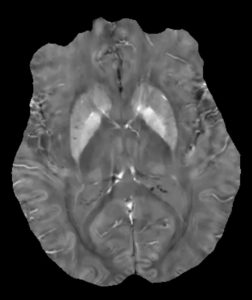Researchers from NeuroSpin (BAOBAB and UNIACT units) and their partner, the startup VENTIO, have just received a funding from EOSC-Life[1] for their joint project QSM4SENIOR. This project aims to evaluate the relevance of an innovative biomarker derived from magnetic resonance imaging (MRI) for the early detection of the development of central nervous system diseases. Researchers will be able to process their data in an open, digital and collaborative space for biological and medical research.
SENIOR, A unique cohort
The causes of neurodegenerative diseases such as Alzheimer's disease are still debated and there are no early markers for these diseases. Since March 2012, NeuroSpin has been conducting the SENIOR study to map imaging biomarkers of normal brain aging, with the hope of identifying early biomarkers in particular. The study is following a cohort of 100 subjects aged 50 to 70 years with ultra high field MRI imaging, at a rate of one session per year over a 10-year period. The infrastructure's MRI scanner technology provides access to resolutions and sensitivity unmatched by conventional imaging systems.
IRON, A PRECIOUS ALLY IN THE DEVELOPMENT OF AN INNOVATIVE BIOMARKER
With the help of the startup VENTIO, the QSM4SENIOR project seeks to add an innovative biomarker: the quantitative measurement of magnetic susceptibility (QSM[2]). This quantity is extremely sensitive to the presence of iron. Although the accumulation of iron in the brain is associated with normal aging, an accumulation above a certain threshold could be a reliable indicator of early cognitive decline and could make it possible to identify affected structures that have not yet been identified. The program therefore provides answers on the normal accumulation of iron in the brain with unprecedented precision.

Example of brain mapping obtained from quantitative measurement of magnetic susceptibility using ultra-high field MRI scanners. Deep structures of the gray matter can be visualized with very fine details and their iron content followed in time. © Ventio/CEA
Contact Joliot researcher:
Alexandre Vignaud (alexandre.vignaud@cea.fr)
[1]The EOSC Life (European Open Science Cloud for Life Sciences) brings together the 13 ESFRI research infrastructures in life sciences.
.